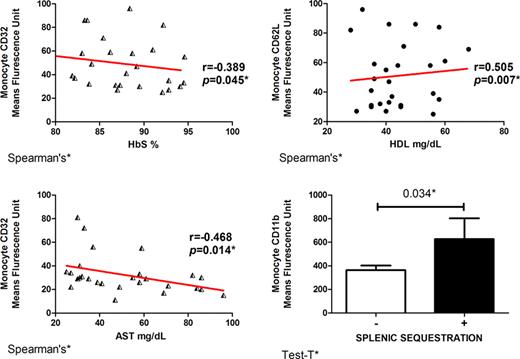Abstract
Abstract 1655
Vaso-occlusive episodes (VOE) in sickle cell anemia, homozygous form of hemoglobin S (HB S), involve interactions between sickle red blood cells (RBC), endothelial cells, leukocytes, platelets, coagulation factors and plasma proteins. The purpose of the present study was explore the inflammatory potential of monocytes, activation state, response against challenge and its association with hemolytic, inflammatory, lipid metabolism and medical history of SCA patients.
We studied 27 SCA patients in steady-state (11 men, 16 women, mean age: 22.26 ± 16.03 years) from Northeast Brazil diagnosed with SCA in attendance of the outpatients clinic of the Foundation of Hematology and Hemotherapy of Bahia (HEMOBA). The control group was compound by 20 healthy Brazilian, with AA hemoglobin pattern matched by age, years and ethnic origin. The study was approved by the FIOCRUZ ethical committee and informed consents were signed by patients or official responsible. The lipid and hemolytic profile were measured by biochemical colorimetric methods, hematological analysis and hemoglobin profile were performed using an electronic cell counter and HPLC, respectively, cytokines and surface molecules expressions on monocytes were evaluated by flow cytometry (labeled with monoclonal anti-CD11b, anti-CD18, ant-CD32, anti-CD62L and anti-HumanTNF), the monocyte activation was stimulated by LPS and the complete medical history was obtained by patients' record.
Our results show higher CD11b monocyte expression in SCA patients than control group (p=0.000) and lower CD18 and CD32 on monocyte expression in SCA patients than control group (p=0.001; p=0.018). After LPS stimulation, we observed increased expression of CD11b, CD18 and CD32 expression on monocyte in SCA (p=0.000) so as in the control group (p=0.000). Moreover, monocyte expression of CD32 was negatively associated with aspartate aminotransferase (r=-0.468; p=0.014) and hemoglobin S (r=-0.389; p=0.045), but presented positive correlation with TNF-alpha (r=0.414; p=0.044). In another hand, the monocyte expression of CD62L was associated with an increase of hemoglobin concentration (r=0.496; p=0.009) and high density lipoprotein-cholesterol (r=0.505; p=0.007). Sickle cell anemia individuals that developed splenic sequestration exhibited increased expression of CD11b on monocyte surface.
The study of monocyte surface molecule and its association with markers of hemolysis, inflammation and lipid metabolism may indicate a differentiated mechanism of these molecules in sickle cell anemia pathogenesis, with a complex involvement of cellular, endothelial and proinflammatory interactions. Additional studies should be carried out in order to explore the contribution of monocyte expression surface molecule on vascular occlusion in the sickle cell anemia.
Monocyte expression molecules associated with lipid metabolism, hemolysis marker and clinic manifestation.
Monocyte expression molecules associated with lipid metabolism, hemolysis marker and clinic manifestation.
No relevant conflicts of interest to declare.
Author notes
Asterisk with author names denotes non-ASH members.


This feature is available to Subscribers Only
Sign In or Create an Account Close Modal